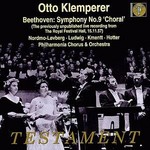
Symphony No.9 in D minor, Op.125 Choral (Rec 1957)
 $38.00
Out of Stock
$38.00
Out of Stock6+ weeks add to cart
BEETHOVEN
Symphony No.9 in D minor, Op.125 Choral (Rec 1957)
Aase Nordmo-Lovberg (soprano), Christa Ludwig (contralto), Waldemar Kmentt (tenor), Hans Hotter (bass) / Philharmonia Orchestra / Otto Klemperer
[ Testament / CD ]
Release Date: Tuesday 11 April 2006
This item is currently out of stock. It may take 6 or more weeks to obtain from when you place your order as this is a specialist product.
"Hearty thanks to Testament for issuing this wonderful document of Klemperer's greatness - caught on the wing."
(MusicWeb June 2000)
"The Philharmonia Chorus made its debut in London's Royal Festival Hall on November 12th and 15th 1957 in performances of Beethoven's Choral Symphony under Otto Klemperer. Columbia recorded this second performance in fine stereo but it's remained unissued, presumably because Klemperer's studio version - made a week later - was given precedence. Testament now makes available a wholly compelling performance, one of the finest 9ths I have heard in many a year.
Klemperer presented music in black and white. His structural focus, his honesty and integrity, gave his music making an unvarnished truth. Rarely one to play music faster than it needed to go, Klemperer's interpretative middle course between two famous contemporary rivals - Furtwangler's mystery and scope, and Toscanini's remorselessness - satisfies the music's direction and resolution. Founded on an orchestral layout of divided violins (so important in clarifying dialogue between the two sections) and with a forward woodwind balance that releases pertinent details, Klemperer leads a performance both monumental and human that absorbs the listener.
The Philharmonia Orchestra responds to the occasion with playing that is insightful, committed and gloriously attuned to Klemperer's concentrated conducting. Klemperer's emphasising of orchestral sonority - such as biting trombones in the last movement and exciting timpani thwacks throughout - makes for invigorating listening. And Klemperer's deliberate tempo for the Scherzo and his observation of its long second repeat makes this movement almost as long as the first, emphasising the symphony's scale. With Klemperer at the helm, a world of rugged sound and sincere expression is created - ideal for Beethoven.
Klemperer's tempi content each movement and are movement-related. This relationship of pulse - a moderate scherzo and flowing Adagio for example - throws a gigantic through-line over the four movements which is maintained in a buoyant reading of the choral finale that comes to life on, and is sustained by, one breath. The Philharmonia Chorus's immaculate tones and unanimous phrasing further distinguish this last movement. The soloists are individually distinctive and respond as a team to Klemperer's direct approach.
As I've already suggested, the stereo sound is excellent. In particular, London concertgoers will recognise the Royal Festival Hall's dry but clear acoustic, an admirable space for Klemperer's unfussy but penetrating conducting. With applause fore and aft, and between-movement coughs and tuning, this is the concert as it took place - a magnificent Beethoven 9. Hearty thanks to Testament for issuing this wonderful document of Klemperer's greatness - caught on the wing."
(MusicWeb June 2000)
"…Otto Klemperer's energy and momentum come not from his tempos but from the way the rhythms are articulated. In the first movement and Scherzo the heroic, teeth-gritted determination are physically gripping, In this Ninth combined urgency with masterly control and spellbinding authority, and a dignity all his own." BBC Music Magazine, February 2010



